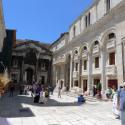Agrippina Landing at Brundisium with the Ashes of Germanicus
Documentation:
West referred to the history of Rome written by Roman historian Tacitus (56-117) when planning Agrippina Landing at Brundisium with the Ashes of Germanicus:
“Agrippina, continuing her course without the least intermission through all the perils and rigors of a sea-voyage in the winter, arrived at the island of Corcyra, situated over against the shores of Calabria. Unable to moderate her grief, and impatient from inexperience of affliction, she spent a few days there to tranquilize her troubled spirit; when, on hearing of her arrival all the intimate friends of her family, and most of the officers who had served under Germanicus, with a number of strangers from the neighboring municipal towns, some thinking it doe as a mark of respect to the prince, but the greater part, carried along with the current, rushed to the city of Brundusium, the readiest part in her way, and the safest landing. As soon as the fleet appeared in the deep, instantly were filled, not the port alone and adjacent parts of the sea, but the walls and roofs, and wherever the most distant prospect could be obtained, with a sorrowing multitude, earnestly asking each other ‘whether they should receive her on landing in silence, or with some expression of feeling?’ Nor was it clearly determined what course would be most suitable to the occasion, when the fleet came slowly in, not as usual in sprightly trim, but all wearing the impress of sadness. When she descended from the ship, accompanied by her two infants, and bearing in her hand the funeral urn, her eyes fixed steadfastly upon the earth, one simultaneous groan burst from the whole assemblage; nor could you distinguish relations from strangers, nor the wailings of men from those of women; nor could any difference be discerned, except that those who came to meet her, in the vehemence of recent grief, surpassed the attendants of Agrippina, who were exhausted with continued mourning.”
Tacitus, The Works of Tacitus, vol. 1, The Annals (New York: Harper & Brothers, 1860), 108.
Allen Staley comments on West’s references to art of the past in Agrippina Landing at Brundisium:
“He did not confine his borrowing to ancient sources. We can identify several other quotations in the painting. The boy who has climbed the column of the temple on the left is a descendant of the boy who has climbed a tree to watch the entry of Christ into Jerusalem in the paintings of Giotto and Duccio. The standing man seen from the rear in the left foreground is based on a figure in Raphael’s Disputa in the Vatican. The figure seated near him with her hand to her head takes on a position traditionally associated with sorrow. The best-known example is he engraving of Melancolia by Dürer, but as Professor Erwin Panofsky has said about Dürer’s print, the motif can be traced back to ancient Egypt. In Poussin’s Death of Germanicus, Agrippina grieves in similar fashion.
These borrowings or references to earlier art are easy to spot in West, and no doubt without a great deal of further research we could identify many more. Because of this, we should not leap to accuse West of plagiarism. He did not try to cover his tracks and conceal his borrowings; in fact, he probably expected his more cultivated patrons to recognize them, just as they would recognize the use of an appropriate quotation in literature. In this, West was following a pattern established by his more august contemporaries. Sir Joshua Reynolds borrowed with such flamboyance that he drew praise for the wit which he could repeat a well-known phrase in a new and unexpected context, and in his Discourses, Reynolds encouraged the young painter to respectful imitation of earlier art:
He, who borrows an idea from an ancient, or even from a modern artist not his
contemporary, and so accommodates it to his own work, that it makes a part of it,
with no seam or joining appearing, can hardly be charged with plagiarism: poets
practice this kind of borrowing, without reserve. But an artist should not be
contented with this only; he should enter into a competition with his original, and
endeavor to improve what he is appropriating to his own work. Such imitation is so
far from having anything in it of the servility of plagiarism, that it is a perpetual
exercise of the mind, a continual invention.”
Allen Staley, “The Landing of Agrippina at Brundisium with Ashes of Germanicus,” Philadelphia Museum of Art Bulletin, vol. 6, no. 287-88 (1 October 1965): 16-17.
Similar Subjects by Other Artists:
Gavin Hamilton, Agrippina Landing at Brindisium with the Ashes of Germanicus, c. 1765 (Tate, London)
About the Artist
Died: London, 11 March 1820
Nationality: American


 Buy the Book
Buy the Book